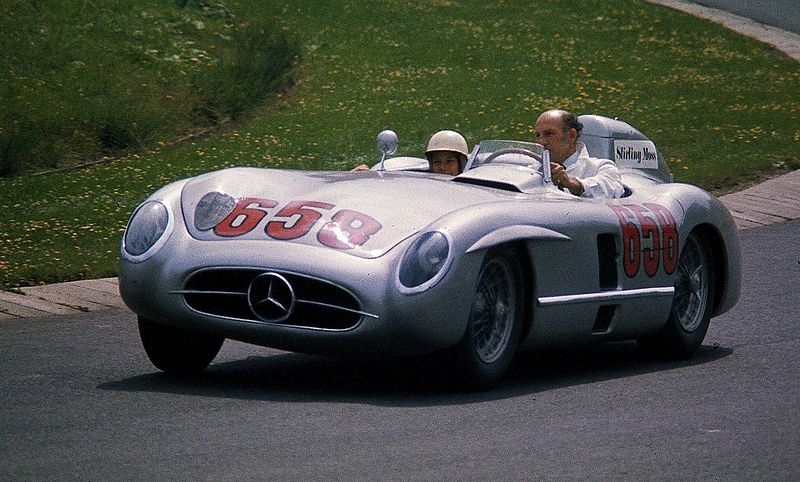“It was a wonderful life, I can’t think of any life for any young man, that’s better than being a professional racing driver.” – Sir Stirling Moss O.B.E (1929 – 2020)
Speed, Heroism, Sportsmanship, Adventure and a True Gentleman are all terms that conjure up the image of the late Sir Stirling Moss O.B.E.
Affectionately referred to by the world as ‘Mr Motor Racing’, his name will forever be remembered as the legend who made the impossible possible and Britain’s greatest all round racing prodigy.
The quintessential gentleman racer.
Born in 1929 to Alfred and Aileen Moss in West Kensington, London, racing was not completely alien for the young Moss. His father too was a pioneer in the English automotive racing scene and had competed in numerous races before, including the world-famous Indy 500.
Speed was both in his and his sister Pat’s genes.
As a youngster, Stirling was an all-round athlete, regularly taking part in sports such as boxing and horse riding. At the age of 18, hungry for speed, he was insistent on buying his first race car. With the support from his father and savings that he had accumulated from horse racing, he bought his first Cooper 500.
Shortly after in 1947, Stirling won in the first event he ever participated in and in 1948, one day after turning 19, he took a significant victory at the Goodwood circuit. The first of many great victories to come.
Moss’ debut in Formula One was at the 1951 Swiss Grand Prix, however it was in 1955 that Moss’s Formula One career took its greatest leap. He was offered a drive in the famous Mercedes ‘Silver Arrows’ team driving alongside the likes of motorsport legend Juan Manuel Fangio. Fangio and Moss were teammates of an all-conquering Mercedes squad for much of his racing career and a close bond was built between the two drivers.
However, one of the many special highlights in Moss’s career was his first Formula One victory in the 1955 season where he became the first ever British driver to win the British Grand prix in a 90-lap epic battle against his world champion team-mate.
His versatility as a driver to excel in various disciplines was put on show on the daunting roads of Italy in the same year. Competing in the 992-mile Mille Migilia was considered no easy feat at the time. It required sheer courage, exceptional skill and mastery of man and machine. The reason for this being that drivers and navigators did not have the opportunity to go out and do practice runs of the course and familiarise themselves of the roads that lay ahead.
Aided by his skillful navigator, Denis Jenkinson, the pair achieved the impossible by winning the race with almost a 32-minute lead to his teammate Fangio. He achieved this feat in which he regards as one of the greatest machines ever built, the Mercedes 300 SLR, a car which has become synonymous with the image of Sir Stirling Moss.
The race which saw Moss and Jenkins averaging a speed of over 100 miles an hour, continuously driving more than eight hours straight was quoted by Moss to be the “greatest drive in his career”.
In 1957, Moss left the Mercedes team and joined Vanwall Motor Racing, preferring to drive for a British team. And in 1958, when Fangio retired from Formula One, Moss would come the closest he would have ever been to a chance of attaining the world title.
Once again, his true sportsmanship and exemplary character was put on display by Mr Motor Racing himself when he would defend his title rival, Mike Hawthorne’s unfair disqualification at the Portuguese Grand Prix.
That year Hawthorne would go on to better Moss by a single point and claim the world championship. The great Enzo Ferrari had been quoted as saying that “if Moss had put reason before passion, he would have been world champion many times.”
Moss would go on to claim 4 consecutive runner-up titles, but the crowning glory of being world champion was always out of reach. No matter, he was still adored by his fans and by the motorsport family, for he was one of the few truly gentleman drivers.
However, Moss’ racing career came to an abrupt end in 1962, forcing Moss to retire from the world of professional racing indefinitely.
A shunt at the Goodwood circuit saw Moss sustain near fatal injuries. He remained unconscious for 4 weeks, and when he came to, he was bed ridden as he was paralysed.
It was almost six months before he could walk again.
His fortitude and never-give-up attitude was incredible as he would get back behind the wheel the following season. Sadly, he would never reach his excellent form after that fatal day.
He lived on in the world of motorsports where he would go on to commentate Formula One races as well go as far as participating in a couple of rallies.
Sir Stirling Moss was a superb touring car driver and set straight-line records with a streamlined MG at Bonneville. Very few others can lay claim to such all-round versatility projected by Mr Motor Racing. Many regard Moss as the best racing driver never to be crowned world champion.
He will continue to live in the history books as a mentor to some and a legend to others as the quintessential gentleman racer.
By Randev Jayasinha

